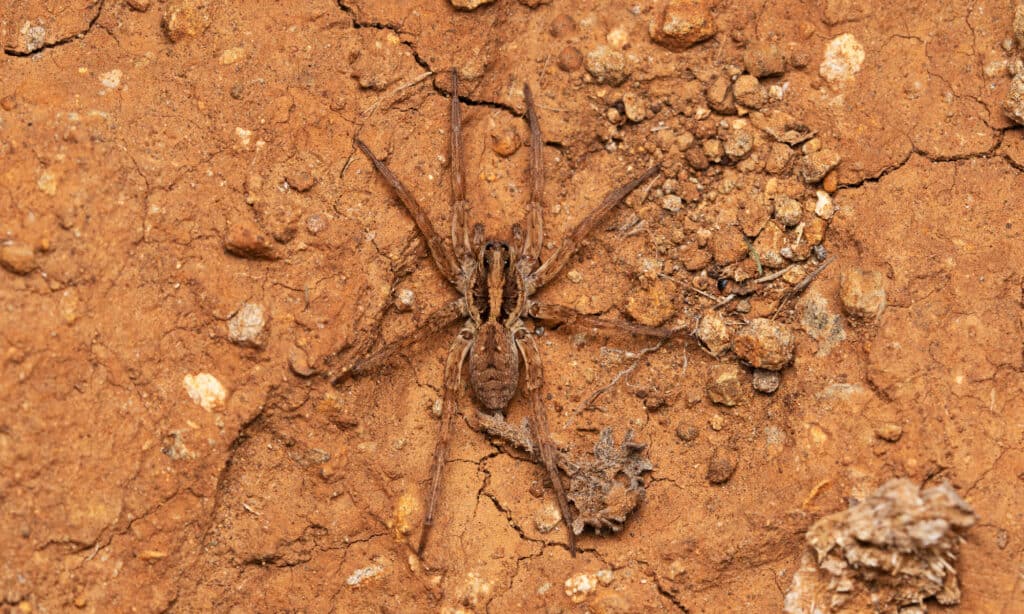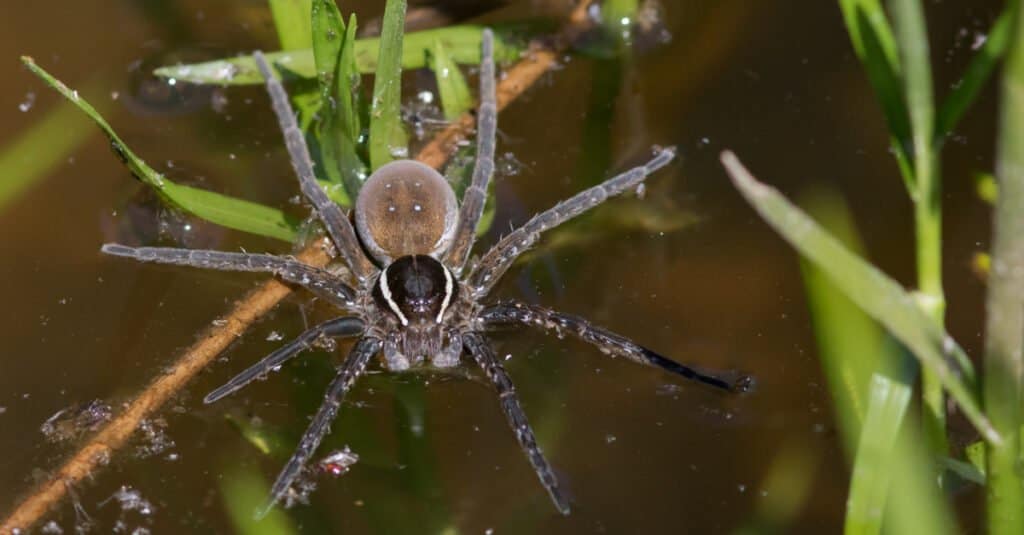Georgia has a humid subtropical climate with short, mild winters and long, hot summers. In other words, the perfect environment for giant critters to thrive. Warmth and moisture are ideal for spiders because it provides them with an abundance of food. Also, you may notice more big spiders around your home and property during the fall when males begin looking for a mating partner.
Are you trying to identify a massive arachnid? Check out the four biggest spiders in Georgia and find out if they’re dangerous.

1. Joro Spider

Joro spiders spin thick 10-foot, wheel-shaped webs that cover telephone poles, trees, and houses.
©Dave Hansche/Shutterstock.com
If you’re from Georgia, you may have heard of this spider. Gaining recent popularity in the state, the joro spider made its way from Japan in 2013, hitching a ride on shipping containers, and it has since invaded Georgia, making its way through neighboring states. Joro spiders are hard to ignore, spinning thick 10-foot, wheel-shaped webs that cover telephone poles, trees, and houses. If their huge webs don’t give them away, their brightly colored bodies will.
Joro spiders have almost neon yellow bodies with black and red markings and long black legs with yellow stripes. With their legs extended, this species can reach up to three inches, about the size of your palm. And while they look menacing, they are relatively harmless to humans. Joro spiders may bite when threatened, but their fangs are not large enough to puncture human or pet skin. The worst symptom someone could experience is a mild allergic reaction, but these spiders are not deemed medically significant.
It’s unknown what impact these invasive orb weavers could have on native fauna, but for now, they are more of a mild nuisance than anything else. If you have joro spiders on your property, spinning their webs where you’d rather them not, simply remove them with a stick to another location. You shouldn’t squish them or use pesticides because killing one will attract many more.
2. Banana Spider

Golden-silk orb weavers thrive in warm, moist regions, where they spin their webs in dense vegetation.
©iStock.com/NikonShutterman
Banana spiders, also known as golden-silk orb weavers, are associated with warm, moist regions around the world, including the Southern United States. Their golden webs are greatly revered; the silk is stronger than kevlar (material used to make bulletproof vests). This species can closely resemble the non-native joro spider, but there are distinct differences. Banana spiders can be reddish to greenish yellow with distinctive white markings on their back and abdomen.
These spiders are sexually dimorphic, meaning the males differ significantly from females. Males only reach 0.2 inches, while females average between 1.5 and two inches. However, in some areas, they’ve been observed to reach five inches.
Banana spiders mainly inhabit warm, relatively wet climates, which are suitable for their hatchlings. You will find them in dense vegetation where insects can easily fly into their webs. But they are also common in urban areas, where predators are less likely to bother them. These spiders are venomous to their prey but have proven only to cause mild reactions in humans. However, the larger the spider, the more venom can enter your system.
3. Wolf Spider

The wolf spider is a familiar home intruder but is shy and harmless to humans.
©iStock.com/ePhotocorp
Wolf spiders are among the most common big spiders in Georgia, often inhabiting homes and backyards. These spiders are typically nomadic and don’t have permanent homes. Their easy-going preferences allow them to have a wide range, living in many different habitats across the state. Don’t be surprised if you find them in your shed or garage.
Wolf spiders range in size, with the smallest less than half an inch and the biggest (Carolina wolf spider) measuring well over two inches. They have eight eyes arranged in three rows, with the middle row having two enormous eyes. It’s no surprise they have excellent vision. These arachnids depend on camouflage for protection, so they don’t possess any flashy colors. Instead, most wolf spiders are varying shades of brown, helping them blend in with their environment (wherever that may be).
It may feel that wolf spiders pose a threat when they accidentally find their way into your home, but they are relatively shy and harmless to humans. They only bite when provoked, and their venom typically causes mild allergic reactions like a dull pain, swelling, and itchiness. If you see one in your house, don’t squish it. Doing so could release hundreds of spiderlings.
4. Fishing Spider

These spiders can reach over 3 inches and spend their days in wooded areas near bodies of water.
©Frode Jacobsen/Shutterstock.com
Fishing spiders are among the biggest spiders in Georgia, measuring over 3 inches, larger than an adult’s palm. These semi-aquatic spiders are from the nursery web spider family and are found near bodies of water or woodland areas. They get their name from their unique hunting strategies, where they quickly run on the water’s surface to catch their prey (aquatic insects, tadpoles, and small fish).
Many people get fishing spiders confused with wolf spiders, but you can quickly identify them by their water habitats, two rows of eyes (instead of three), and the striking pale stripes down each side of their body. They have specific physical characteristics that allow them to inhabit aquatic areas. The tiny spiny hairs on their legs detect vibrations on the water’s surface, and their body is covered in a waxy substance that repels moisture. In Georgia, these spiders are prevalent in freshwater, and you may even find them in your swimming pool.
Fishing spiders may look creepy as they cling to trees and run on water, but they are harmless to humans. Like most spiders, they contain venom to help them catch prey, but it’s ineffective on people unless an individual is specifically allergic to it.
Summary Of The 4 Biggest Spiders in Georgia
| Spider | Size | Harmful to Humans |
|---|---|---|
| Fishing Spider | Over 3 inches | No, unless they are allergic to the venom |
| Wolf Spider | 0.5-2 inches | Their venom typically causes mild allergic reactions like dull pain, swelling, and itchiness. |
| Banana Spider | 0.2-2 inches | Venom only causes mild reactions in humans |
| Joro Spider | 0.5-3 inches | Fangs aren’t large enough to puncture skin but may cause allergic reactions |
The photo featured at the top of this post is © Kelly vanDellen/Shutterstock.com
Thank you for reading! Have some feedback for us? Contact the AZ Animals editorial team.






